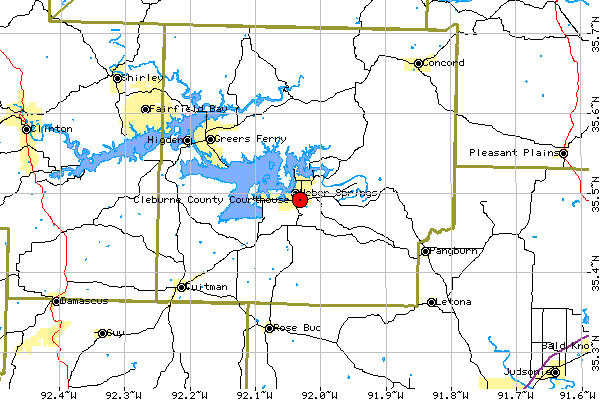We have recorded for us the arrival of another wagon train bringing settlers to Arkansas from Tennessee. This article was written by Robert E. Lee Flowers who married Lucy Turney, the daughter of Willaim Allen Turney, the son of Henry Turney. For the enrichment of the reader we have left the text intact.
November 16, 1886 a wagon train rolled over the hills into Sugar Loaf Springs (now Heber Springs) a temporary destination to a final goal of "Salt Springs Barrens". Among the party was an aged bearded man, Uncle Tim Flowers, his wife Aunt Lou, and son and daughter Bob and Anna. These people in quest of a home sighted Cullums Flatwoods, the finest pinery I ever saw and contacting Uncle Billy Holmes (Uncle Blinker Holmes) bought his squatters cabin. It was a 13′ X 16′ log shack, ridge pole roof, cobble stone chimney, door hung on wooden pegs on outside (no room inside) and every time it opened said hard times! Beds were bunks pegged to wall in two corners, this writer whanged up a trundle bed shoved under another bunk.
From this cabin we heard the panthers scream and the wolves howl and at least one bear was killed in passing. Deer by the half dozens loped down the ravine and sighting 20 odd turkeys was common. Contacting neighbors we found the most generous hill people that ever lived, an old Methodist Church, Old Bethel, to which people from a radius of miles would come in ox wagons or even in better vehicles, others on horseback or afoot.
They’d bring their children (to the church) and spread bedding in the corners; there’d be singing and preaching that moved to spiritual uplist and Uncle Abe Turney would talk to God in prayer in a way that could not be denied. Here’s where the old sister said "Praise God!…somebody hold my baby while I shout!"
Ater the meeting Charley Turney would say "everybody go home with me!" and sure enough there’d be a big crowd accept. I never knew a more hospitable man than Charley Turney and Aunt Jeannie made the finest coffee and big fat biscuits and there was pork roast, taters, gravy and vegetables galore.
Old Bethel Community must have a new district school! So the Lynns, Turneys, Whitakers, etc., got together and soon by the help of everybody a new Union Church and school house and a new district (#38( was established.
The writer was one of the early teachers, taught twelve terms within walking distance of home. Bethlehem 4, Bethel 6, Cullum 2, three miles to any point. A moving spirit was William Allen Turney (Bill Allen) who lived at least four miles from Old Bethel but who patronized not only his own school but his son John attended Quitman and Heber schools and with the writer four terms.
George Allen Turney, the youngest son, was with this writer 8 terms, one term at Kinderhook, now Edgemont. This writer and George A. Turney ate together, roomed together, studied together, slept together and bonds of allegiance drew us closer than buddies.
About the year 1894 Charley Turney and T.A. Stuart built a saw and grist mill and a cotton gin. Andrew Lynn, Jr. for several years had a blacksmith shop, as huckster kept dry goods and groceries.
This section for many years had received mail at Shiloh, Eglantine and Kinderhook 5 to 10 miles away and across Little Red River. A branch route from Morganton was extended to Chalk, McLehaney, Scott and Smallwood communities. Later on Higden, named for a family of long residents in Saline township (old Uncle Tommie Higdon) whose only son, Dave, lived near Old Higden, home of the Uncle Davy Nicholson place. The Higdons had connections with the Codys, Crocketts, Woods, Turneys, Thomasons.
John Calvin Turney son of Bill Allen Turney established a general store at Higden in the late 1870’s but later moved to Quitman. George A. Turney moved to Higden where he had various enterprises; left three sons and two daughters.
Robert E. Lee Flowers first married Lucy, a daughter of Bill Allen Turney (Wm. A. Turney), she passed away and left also five children. George Allen (Red George) Turney was also married to a Lucy (Allison).
On October 16, 1911 Andrew Lynn was paid $25.00 for one acre of land that was to become the Higden Cemetery. The Higden, Lower Barnes (Barrens), Turney and Treadway Cemeteries were relocated at the Hidgen-McLehaney Cemetery July 1960, due to the forming of Greers Ferry Reservoir. Sylvia Ibbotson has compiled a comprehensive list of graves in the old cemeteries, and graves, numbers and names or relocation in the Higden-McLehaney Cemetery.
This is from the Spring 1987 issue of Cleburne County Historical Journal.

 Edgemont School Building
Edgemont School Building  Quitman College Building Built 1891
Quitman College Building Built 1891 

 CASE FORD EDDY
CASE FORD EDDY Heber Springs Spring Park
Heber Springs Spring Park Sugar Loaf Mountain
Sugar Loaf Mountain Tumbling Shoals Swinging Bridge
Tumbling Shoals Swinging Bridge